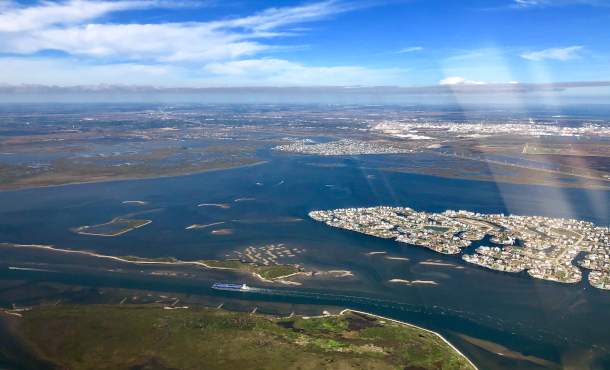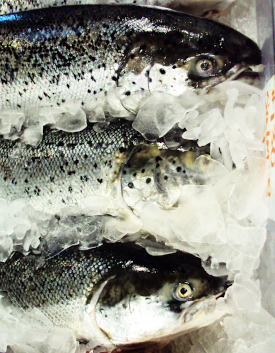Fishing for Data on Chemical Runoff
Air Date: Week of January 14, 2022

Galveston Bay, in the western Gulf of Mexico. (Photo: Adam Reeder, Flickr, CC BY-NC 2.0)
Houston, Texas is a hub for the US petrochemical industry and just downstream is Galveston Bay, an important ecosystem and fishery for the region. Houston Public Media reporter Katie Watkins reports on research to test fish living in the Bay for chemical exposure from run off.
Transcript
DOERING: Houston, Texas is one of the cancer hotspots ProPublica identified in its analysis of compounding chemical exposures. Houston is a hub for the US petrochemical industry and just downstream is Galveston Bay, an important fishery for the region. And scientists are trying to learn how industrial runoff might be affecting marine life there. Katie Watkins is a reporter with Houston Public Media and has the story.
WATKINS: I meet Sepp Haukubo, with the Environmental Defense Fund, and our captain LG Boyd at a dock in Texas City at the crack of dawn. We set off into the bay as the sun rises, and we can see Houston's industrial complex in the background. The two men set up their fishing equipment and Haukubo explains what they're looking for.
HAUKUBO: We have caught a lot of trout, so we're trying to get a few more red fish, some black drum. Ten's probably a good number total.
WATKINS: We won't be eating these fish. Instead, they'll be sent to a lab at Texas A&M University, where they'll be tested for the presence of certain chemicals and metals that are associated with the petrochemical industry.
HAUKUBO: So we will at least know that it didn't come from, you know, runoff from somebody's yard, or from you know, city streets--that it really did come from a group of facilities.
WATKINS: By sampling the fish, the researchers hope to understand what toxic compounds are getting into the bay during flood events and how they're building up over time.

Fish, like this speckled trout in a Seabrook, Texas market, can provide an indicator of pollution levels in water. (Photo: Patrick Feller, Flickr, CC BY 2.0)
HAUKUBO: You know, I eat plenty of seafood out of Galveston Bay, I eat oysters, I eat the fish I catch but that's exactly one of the reasons that we're conducting this study is so that we can get a better idea of what are some of the health risks, but also what are some of the risks to the ecosystem, right?
WATKINS: The state issues, warnings if fish aren't safe to eat and state and federal organizations have tracked similar data. This research builds on that.
CISNEROS: So we would be able to tie current data with historical data and kind of come up with new trends to track how things have changed over time.
WATKINS: That's Charlotte Cisneros with the Galveston Bay Foundation, which is also involved. She says because these fish are higher up in the food chain, they're good gauges of what chemicals are accumulating in the ecosystem.
CISNEROS: They're just kind of overall good indicators of health in the area.
Katie Watkins: Alina Craft, with the Environmental Defense Fund, says sampling the fish is just one part of the research. The chemicals that show up can be used to help identify which industrial facilities they may be coming from.
CRAFT: We're trying to understand more about, okay, well, where would these compounds have come from in terms of the industrial facility? And so really trying to understand what are the facilities that may be at greatest risk based on where they're located based on the compounds that they manage or use in their operations and so forth.
WATKINS: As the final step, they'll propose nature-based solutions that could help mitigate the pollution, things like oyster beds and green spaces that slow the flow of runoff. She says as climate change is making hurricane stronger and wetter these solutions are all the more urgent. Back on the fishing boat, we aren't having much luck. Most of the fish are either too small or the wrong kind. [WATER SPLASHING] So too short again?
HAUKUBO: Too short [LAUGH]
WATKINS: Boyd and Haukubo cast and reel, again and again until...
BOYD: There we go! Beauty now where the science starts.
Katie Watkins: It's a 20 and a half inch black drum named for the drumming noise it makes. [BLACK DRUM SOUND] Next Haukubo puts it in a Ziploc bag and into a cooler. He writes down the time, location, water temperature and other data points. By the end of the day, they had caught nine fish to be transported to the lab for testing, where they'll offer insights into the pollution in our bay. For news 88-7 in depth. I'm Katie Watkins.
DOERING: That’s environmental reporter Katie Watkins. Her story comes to us courtesy of Houston Public Media.
Links
Living on Earth wants to hear from you!
Living on Earth
62 Calef Highway, Suite 212
Lee, NH 03861
Telephone: 617-287-4121
E-mail: comments@loe.org
Newsletter [Click here]
Donate to Living on Earth!
Living on Earth is an independent media program and relies entirely on contributions from listeners and institutions supporting public service. Please donate now to preserve an independent environmental voice.
NewsletterLiving on Earth offers a weekly delivery of the show's rundown to your mailbox. Sign up for our newsletter today!
 Sailors For The Sea: Be the change you want to sea.
Sailors For The Sea: Be the change you want to sea.
 The Grantham Foundation for the Protection of the Environment: Committed to protecting and improving the health of the global environment.
The Grantham Foundation for the Protection of the Environment: Committed to protecting and improving the health of the global environment.
 Contribute to Living on Earth and receive, as our gift to you, an archival print of one of Mark Seth Lender's extraordinary wildlife photographs. Follow the link to see Mark's current collection of photographs.
Contribute to Living on Earth and receive, as our gift to you, an archival print of one of Mark Seth Lender's extraordinary wildlife photographs. Follow the link to see Mark's current collection of photographs.
 Buy a signed copy of Mark Seth Lender's book Smeagull the Seagull & support Living on Earth
Buy a signed copy of Mark Seth Lender's book Smeagull the Seagull & support Living on Earth

